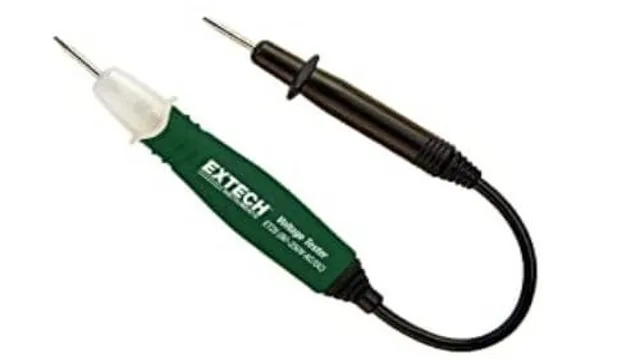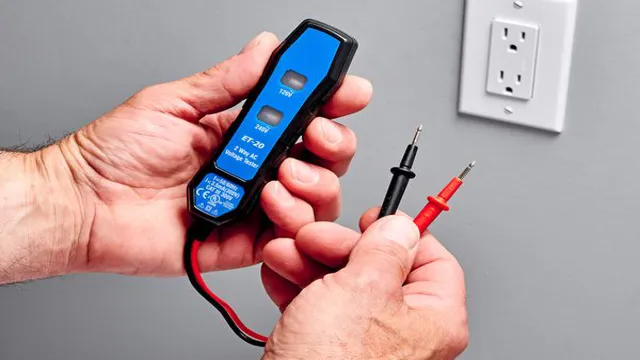If you’re an electrician or a DIY enthusiast looking to identify electrical current, then a neon voltage tester is a must-have tool. It is a simple, yet effective device that helps you identify whether a wire or circuit is live or not. This tester works by using neon lamps, which light up when they detect an electrical current.
With a neon voltage tester in hand, you can easily identify potentially hazardous wiring situations and avoid accidents. In this blog post, we’ll explore the basics of using a neon voltage tester and share some best practices when working with electricity. So, let’s get started!
What is a neon voltage tester?
“How to Use a Neon Voltage Tester” If you’re working with electrical wires, it’s important to know whether there’s voltage running through them. That’s where a neon voltage tester comes in handy. This small tool measures the presence of voltage, typically between 120 and 600 volts AC.
Using a neon voltage tester is a fairly simple process: first, make sure the tool is working properly by touching the tip to a known live wire (one that you’re certain has voltage). The tester should light up or beep, indicating that it’s working. Then, touch the tip to the wire you want to test.
If the tester lights up or beeps again, that means there’s voltage present. If not, the wire is likely safe to handle. Remember to always practice caution and safety when working with electricity.
A neon voltage tester is a valuable tool to have in your electrical toolkit, but it’s important to use it correctly to ensure accuracy and prevent accidents.
Explaining its purpose and construction
A neon voltage tester is a device that is commonly used by electricians and homeowners to check the presence of electrical voltage in a circuit. Its purpose is to keep users safe by ensuring that the power has been turned off before any electrical work is performed. The construction of a neon voltage tester consists of a neon bulb, two insulated wires with metal probes at the end, and a plastic or rubber handle.
When the probes are touched to an electrical source, the neon bulb lights up to indicate the presence of voltage. The device works by using the neon gas within the bulb to ionize with the electric current, creating a bright glow. This simple yet effective tool is a must-have for anyone who works with electricity and wants to ensure that they are working safely.

Safety Precautions
Using a neon voltage tester is a great way to ensure that you are working with safe levels of voltage in your electrical projects. However, it is important to take proper safety precautions when using this tool. First and foremost, always make sure that the tester is in good working condition before using it.
Check for any damage or signs of wear before plugging it in. Secondly, always wear protective equipment such as gloves and safety goggles to protect yourself from any potential electrical shock. Thirdly, never touch the metal tips of the tester while it is on, as that could result in an electrical shock.
Finally, always be aware of your surroundings and make sure that no other electrical devices are connected to the same circuit that you are testing. By following these simple guidelines, you can safely use a neon voltage tester in your electrical projects and ensure that you are working with safe levels of voltage.
Important things to remember when using a voltage tester
Voltage tester, safety precautions Using a voltage tester properly is crucial to ensuring your safety, but there are a few important things you should keep in mind before using one. First and foremost, always make sure to turn off the power source before testing any electrical equipment or wiring. This can be done by locating the corresponding breaker switch in your circuit box and turning it off.
Additionally, make sure that your hands are dry and that you are standing on a dry surface before using the voltage tester. Wet conditions can increase the risk of electrocution. It’s also important to use a voltage tester that is designed for the specific job you are performing.
Using the wrong type of tester can lead to incorrect readings and accidents. Lastly, always read and follow the manufacturer’s instructions for the voltage tester you are using. By taking these safety precautions, you can greatly reduce the risk of injury when using a voltage tester.
Steps to use the neon voltage tester
Neon voltage testers are handy tools that allow users to determine the presence or absence of electricity in a circuit without having to touch a wire. To use a neon voltage tester, the first step is to ensure that the tool is working correctly. To do this, simply insert the tip of the tester into an outlet or another live electrical source, and the neon tube inside the tool should light up.
Next, ensure that the circuit you wish to test is off. Insert the tester’s tip into the outlet or switch you wish to test and observe the neon tube. If the tube lights up, electricity is present, but if it does not, the circuit is dead.
Remember to hold the tool only by its insulated handle and to keep your fingers away from the metal tip at all times. By following these simple steps, you can use a neon voltage tester to check for voltage and properly diagnose problems in electrical circuits.
Step-by-step guide to using the tester on electrical outlets and switches
Electrical outlets and switches, neon voltage tester, step-by-step guide If you’re planning to work on your home electrical system, it’s crucial to have the proper tools, and one of the most essential is a neon voltage tester. This device can help verify if an outlet or switch is live or not, which can help prevent electrical accidents. Here is a step-by-step guide on how to use a neon voltage tester on your outlets and switches.
First, locate your electrical source or circuit panel and switch off the power source connected to the outlet or switch you plan to test. Next, switch on the tester and hold it against the outlet or switch. If the tester register’s a steady green light, the outlet or switch is not live and safe to work on.
If the tester registers a red light, the outlet or switch is live, and you need to switch off the power and avoid working on it until it’s safe to do so. It’s crucial to ensure proper safety measures while working with electricity. Wear protective equipment, keep children and pets away, and follow standard electrical safety practices.
By using a neon voltage tester, you can simplify the process of testing the live connections and ensure your safety while working on your home’s electrical system.
Tips on interpreting the results of the voltage tester
When it comes to using a neon voltage tester, it’s important to follow a few simple steps to ensure accurate readings every time. First, make sure the tester is properly grounded by touching the metal clip on the end to a grounded surface. Next, insert the tip of the tester into the outlet or wire you want to test.
The neon light should illuminate if there is voltage present. It’s important to note that just because the light is on, it doesn’t necessarily mean the voltage is high enough to power a device. To interpret the results, check the voltage level on the tester if it comes equipped with a measurement feature.
If not, use a multimeter to measure the voltage and compare it to the safe operating level of the device you plan to use. Remember to always exercise caution when working with electrical outlets and wires, wear protective gear and follow all safety precautions to avoid injury. By following these simple steps, you can use a neon voltage tester with confidence and accuracy.
Conclusion
In conclusion, using a neon voltage tester is both simple and essential for any electrical work you may need to do. It’s as easy as finding an outlet or wire, inserting the tester, and observing the reaction of the neon bulb. Just remember, the tester is only as good as the person using it – so be sure to follow proper safety procedures and always double-check your work.
With a little practice and caution, you’ll be a voltage testing pro in no time!”
Final thoughts on using a neon voltage tester safely and effectively
Using a neon voltage tester can be a handy tool when working with electrical systems, but it’s essential to understand how to use it correctly to avoid any risk of injury or damage. Here are some steps to consider when using a neon voltage tester. First, make sure to check the tester’s battery and the neon bulb’s condition before commencing use.
Next, turn off the circuit breaker or remove the fuse from the electrical outlet that you’ll be testing. Place the tester’s probe into the outlet’s hot slot, keeping your hands and fingers away from the metal parts of the tester. If the neon bulb lights up, then electricity is flowing to the outlet.
With the tester still in place, turn the circuit breaker back on or replace the fuse and check that the voltage is present at the outlet. Finally, remove the tester from the outlet, and don’t forget to turn off the circuit breaker or replace the fuse again. Remember, always wear appropriate protective gear and follow safety instructions specific to your neon voltage tester.
If you’re unsure about the condition of your electrical system or don’t feel comfortable with testing it yourself, it’s best to hire a professional electrician. By following these simple steps and taking the necessary precautions, you can safely and effectively use a neon voltage tester to test your electrical outlet. Stay safe, and good luck with your electrical work!
FAQs
What is a neon voltage tester?
A neon voltage tester is a tool used to detect the presence of electric voltage in a circuit.
How does a neon voltage tester work?
A neon voltage tester works by using a neon lamp that illuminates when it comes into contact with electric voltage.
Is a neon voltage tester safe to use?
Yes, a neon voltage tester is safe to use as long as proper safety precautions are followed, such as wearing protective gear and ensuring the tester is working properly.
Can a neon voltage tester test for DC voltage?
No, a neon voltage tester can only test for AC voltage.
How do I use a neon voltage tester?
To use a neon voltage tester, first, make sure the circuit is turned off. Then, touch the tip of the tester to the circuit you want to test. If the neon lamp lights up, that means there is voltage present in the circuit.
What are some common applications for a neon voltage tester?
A neon voltage tester can be used in a variety of applications, such as testing outlets for live voltage, testing light switches and fuses, and checking wiring connections for loose connections or damaged wires.
Do I need to calibrate my neon voltage tester?
No, neon voltage testers do not require calibration. However, it is important to regularly check that the tester is working properly before each use.






